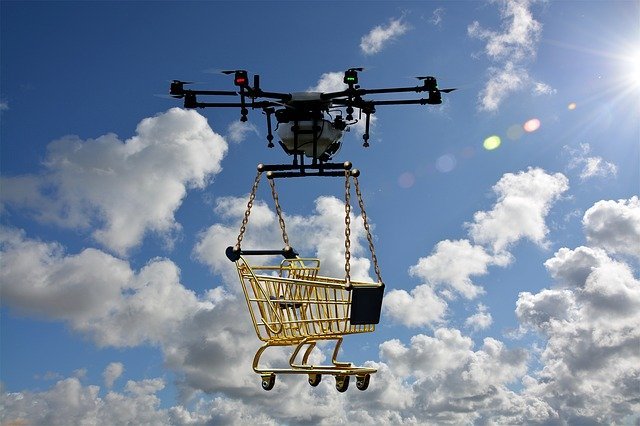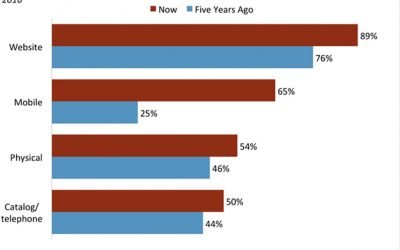I recently wrote this investigative piece on the supply chain crisis for SCORE Greater Phoenix and with permission, am replicating it here. I started my business career in retailing right after college. As I was putting together a webinar for SCORE — the video is available here — on preparing for the 2020 holiday sales season (which will be “unprecedented” like 2020 has been), I realized that the pandemic also affected global supply chains and did some investigative reporting and this article was the result. If retailers — whether ecommerce or brick-and-mortar — can’t get their products in stock or delivered, what are they going to market?
The 2020 Unprecedented Holiday Sales Season

This holiday season will be like no other before. Retailers compare year over year, however, the COVID-19 pandemic has turned the world upside down to say the least. At the beginning of the pandemic, the supply chain crisis was focused on delivering not just medical equipment, but household necessities like food, toilet paper and cleaning supplies.
The challenge is that the holidays are coming pandemic or not. Consumers still want to buy gifts. Travelers who cancelled vacations want to spend that money on themselves and their loved ones.
We don’t know when the vaccine will be available to the general public. Another question is who will get it first? How soon will shoppers feel comfortable going to a mall?
Things Retailers Need to Consider:
- How the consumer now shops — either online or through apps
- Order fulfillment — curbside pickup or delivery
- Delivery Timing — same day, next day, 3-days or more?
The Need to Digitize and Adapt Technology

There are still a lot of paper-based systems out there that need to be digitized and interconnected. That includes investing in technologies like automation, AI – artificial intelligence, apps, robotics, etc.
“The current model of globalization, particularly global supply chains, seems to be under threat of a radical reconfiguration.”
Source: https://iap.unido.org/articles/impact-covid-19-manufacturing-investments
They’re looking at shorter supply chains. Let’s say a product has 3 major components. Each component is manufactured in a different country. Why? Mostly because of cost. If something is cheaper to manufacture in China than Thailand, then it’s made in China. So, each of the components are shipped to a final assembly plant in yet another country.
What the pandemic did is disrupt the chain. Not only were workers getting sick and production halted, but countries stopped importing and exporting. The only thing that was getting through were medical supplies and equipment.
However…
“Unlike previous disruptions to supply chains, such as following the Fukushima disaster or the floods in Thailand, it is highly unlikely that we will see a return to ‘business as usual’.”
Source: https://iap.unido.org/articles/impact-covid-19-manufacturing-investments
Adapting to technology is not an overnight occurrence. Big guys like Walmart, Amazon, Best Buy, etc., have buying power, as well as, the capital to invest in digital technology.
Companies with agile supply chains outperform their peers.
Suppliers need to be flexible. If the retailer doesn’t know where their inventory is, how can they promote or sell it?
For the little guy, like the online ecommerce store, the holidays are coming whether their supply chain has adapted or not.
Warehousing and eCommerce Logistics

“Today, eCommerce is the primary driver of small package logistics. More importantly, small packages make up $82.2 billion of the logistics industry, and that number will only grow from here. As a result, more incoming orders and greater order diversity naturally requires increased numbers of warehouses. Fortunately, some shippers have a plan for enhancing warehouse usage.”
Some new innovations include:
- Inventory control
- Real-time analytics
- Smaller, localized regional centers
- Third-party logistics providers (3PLs) with large global footprints to help keep costs down
Source: https://cerasis.com/ecommerce-logistics/
Supply Chain Automation
The recent “2020 Supply Chain Survey” by enVista, details the development of new policies and procedures…
“For some stores, picking, packing, and shipping from stores is an entirely new concept; in others, the infrastructure is in place, but the labor processes and training are not,” according to the study. “In most cases, additional processes and technology are required to standardize the desired customer experience.”
Evaluating the progress being made in key delivery/fulfillment areas, the survey found:
- Two-day delivery: 92 percent had implemented, 28 percent indicated it needed improvement;
- One-day delivery: 84 percent had implemented, 46 percent indicated it needed improvement;
- Same-day delivery: 64 percent had implemented, 42 percent indicated it needed improvement;
- BOPIS (buy online pickup in store): 84 percent had implemented, 24 percent indicated it needed improvement;
- Ship-from-store: 87 percent had implemented, 47 percent indicated it needed improvement;
- Vendor drop-ship: 78 percent had implemented, 40 percent indicated it needed improvement.
Source: https://retailwire.com/discussion/how-can-automation-help-omnichannel-fulfillment/
Cybersecurity
On top of the problems caused by the COVID-19 pandemic, cybercrime is up. Everyone is getting hacked — from trucking companies to online stores. With everyone going digital, this opens security threats.
“…there are 375 new cyber threats occurring every minute, which compromise more than 16,000 records per minute.”
Source: https://news.yahoo.com/e-commerce-expands-does-cybercrime-202559928.html
In regards to supply chain…
TFI International, which ranks No. 11 on the Transport Topics Top 100 list of the largest for-hire carriers in North America, confirmed recent reports that four of its Canadian-based courier divisions were hit by a ransomware attack Aug. 20. This came less than a month after the FBI warned truckers that cybercriminals could target electronic logging device vulnerabilities as a means of seizing business information.
Source: https://www.ttnews.com/articles/fleets-face-increasing-cybersecurity-threats-experts-say

In case you’re not familiar with the term “ransomeware”, it’s when you accidentally download something from an innocent-looking link or website and it installs a program in your computer or server. To get it removed, you have to pay someone a ransom, usually in bitcoin. Hijacking of websites is very easy if you don’t have any security programs installed.
If you use a 3rd party ecommerce site, security falls on their shoulders. If you manage your own website, it’s yours. You have to make sure your platform is updated, secure and you back-up daily. If you’re not very techie, it’s best to hire an outside website security firm.
Made in the U.S.A
Yes, more manufacturing will be “re-shored” rather than stay “off-shore”. This, however, will probably affect costs. Raw materials may still need to be shipped from outside the country and those costs are going up.
Retailers should buy their stock now at current prices.
I contacted one of my coaching clients, Stephanie, who has an online jewelry boutique. She buys her inventory and keeps it in stock. She has a supplier in Canada who tells her that some pieces are on backorder. If she orders a dozen, and he only has 10 in stock, what he’s doing is shipping the 10 he has and shipping the other 2 when he gets them in at no additional processing charge. The supplier is flexible. He has to be.

How Supply Chain Affects Your Marketing
You can’t promote a product you don’t have because you may not get it. Don’t promise delivery unless you can fulfill within a reasonable amount of time. I remember ordering a necklace that I saw advertised on Instagram. What the vendor failed to do was tell me when I could expect my order. I did get a link to a Chinese app that told me, in Chinese, when it shipped — direct to consumer — from somewhere in China. Two weeks turned to three, then four. I contacted the vendor to no response. The app never updated where my package was. I got it 5 weeks later.
I wouldn’t have been upset had the vendor notified me that there was a delay or it was on backorder — something. And this was before COVID-19! Needless to say, I won’t be buying from that vendor again.
Selling Internationally

What about when Europeans want to buy American products? There are higher shipping costs and they could be a logistic nightmare taking too long for a package to get to the buyer. Potential customers will abandon their shopping carts when they see high shipping costs or long delivery delays.
“To overcome these hurdles, GEODIS is launching “GEODIS MyParcel”, a direct-to-customer intercontinental delivery service with guaranteed delivery times at a lower cost. “With the explosive growth of international e-Commerce, our customers want to offer consumers a premium service at a completely transparent price,” explains Manoj Pankaj, Vice President Cross-Border e-Commerce of GEODIS.”
Source: https://theloadstar.com/geodis-offers-e-commerce-brands-direct-to-customer-intercontinental-delivery-service/
Necessity is the Mother of Invention, Innovation and Change
Never has this phrase been truer. Here are some new ideas that have been dreamed up…
FedEx
- FedEx Logistics is adding a Foreign Trade Zone (FTZ) location in El Paso, Texas, the logistics provider announced Thursday. It also has locations in Los Angeles, New York, Dallas and Chicago.
- The City of El Paso’s infrastructure and proximity to the Mexican border allows for the efficient movement of goods, FedEx said in its release, adding that its FTZ network will complement existing freight forwarding services. The automotive and electronics sectors are especially common users of FTZs, a FedEx spokesperson said in an email.
- “This new FTZ is a secure, controlled area that is treated as if it is located outside the U.S., which enables customers to benefit from duty and tax incentives and a portfolio of logistics solutions,” FedEx Logistics CEO Udo Lange said in a LinkedIn post.
Source: https://www.supplychaindive.com/news/fedex-foreign-trade-zone-texas-el-paso/584717/
DOT
- The Department of Transportation released a National Freight Strategic Plan Thursday to help implement the National Multimodal Freight Policy. The plan outlines goals and strategies to guide multimodal freight policies, investments and programs at the federal and state levels. The policy and its plan were created under the Fixing America’s Surface Transportation Act — passed in 2015 and set to expire Sept. 30.
- The plan identifies freight challenges and data and research needs, and intends to provide a framework for increased cross-sector and cross-mode collaboration between federal, state and local authorities. It was developed with input from multiple agencies, as well as carriers, shippers and other stakeholders in the public and private sectors.
- According to the plan, the federal government will contribute in four overarching ways: updating or eliminating regulations that increase costs for shippers and consumers; improving collaboration between stakeholders, including multi-state investment; providing federal funds specifically for freight projects; and investing in data, analytics and research.
In the end, the consumer doesn’t really care HOW their order gets to them, just that it gets delivered in a reasonable amount of time at a reasonable cost. We know that consumers will pay for faster delivery. It’s just a matter of determining how much.
Airlines are removing seats to make room for cargo. That’s smart. People aren’t flying, but cargo is. Adapt or die.
Put the Consumer First
- 67% of consumers indicate that inventory visibility across stores, online and mobile is an important service to offer
- 65% of consumers indicate that the ability to buy anywhere, ship anywhere is an important service to offer
- 48% of consumers indicate that the ability to pick up an online purchase in-store is an important factor when choosing what store to shop at
Source: https://www.envistacorp.com/coverage/2020-envista-supply-chain-survey-findings
Whenever there’s a major change, you have to take a step back and do extensive market research. Fortunately, we’re enough into life in a COVID-19 world to have a lot of data available and most is free. It just takes a little digging.
To be better able to please the consumer, you need to clearly identify who they are. Have they changed? How have their habits changed? How has COVID-19 changed their pain points?
The two top consumer needs when shopping is safety and convenience. For a brick-and-mortar location, if they don’t feel safe, they’ll leave. For ecommerce, if the shopping cart and checkout experience is cumbersome or not secure, they’ll also leave.
Ecommerce
“Ecommerce is here to stay. It’s as simple as that and as we move forward, firms need to get with the ecommerce program or get left behind.
While ecommerce sales were growing before the pandemic, Covid-19 has accelerated society’s move towards this. It’s not just that people are buying more online, who and what people are buying is changing. The pandemic has seen a significant increase in older people (60+) shopping online and a broader range of products available such as sporting goods as home office items. To some, this may seem like a fad, which will change as things start to get back to normal. However, when looking at different patterns of recovery from Covid-19, in every scenario, there is an expected year on year increase in ecommerce to be between 25-32%.
As ecommerce grows, it is also ever-changing with common supply chain trends such as sustainability and technology also impacting ecommerce. New technology will particularly play a role in the future of ecommerce logistics. Customers want their order as soon as possible. Amazon’s hopes of delivering goods within two hours of offering is setting the standard, which other companies will have to try and match.”
Source: https://www.allthingssupplychain.com/the-next-chapter-for-the-supply-chain-the-3-most-important-topics-shaping-the-future/
The Last Mile

“The very nature of online shopping means that customers who do so are expecting convenience, choice and smooth online experience. The convenience of being able to buy with just a few clicks needs to carry over to a delivery experience that’s just as convenient. Customers want the flexibility to decide how they will receive their parcel so they can choose a delivery that offers minimal disruption to their daily routine. This includes Click and Collect locations, day/time selection and different price points. How important are these options? According to IMRG, 45% of customers will abandon a purchase if there is a lack of convenient delivery option and 95% of consumers will shop elsewhere if delivery options don’t suit their needs. Ensuring that you can give your customers the flexibility over their final mile experience can be the difference between a sale, or the customers going to a competitor.
Once you secure a sale, the final mile delivery experience continues to be important for customer loyalty. 70% of consumers consider all types of pre-delivery notifications important according to IMRG and want to be able to track their parcel in real-time. Constant communication, including warning them of any delays that may occur, is essential for a customer feeling they have had a good experience even if things don’t arrive exactly when they want it to.”
Source: https://www.allthingssupplychain.com/how-does-last-mile-delivery-affect-your-ecommerce-brand/
Data and Analytics are Crucial for Each Stage of the Supply Chain

Keeping track of what’s working and not working is critical to being able to manage a crisis or unexpected change.
Here’s where researching your competition comes in. If Amazon gets their drones working and they snatch up empty retail locations to use them as neighborhood fulfillment centers, then their competitors need to do the same. Walmart already has the neighborhood stores. Don’t be surprised if you see a Walmart drone delivering to a house near you.
Customer satisfaction surveys work. Keep them short and don’t bug people if they don’t respond. Use the data to adjust goals, strategies and tactics each month. Yes, you should plan somewhat for long-term, but have month-to-month goals and strategies.
A year ago when we were planning for 2020, no one planned for a pandemic, let alone one that lasted for so long and we still don’t know what’s ahead.
Forecasting at the Micro Level
Artificial Intelligence (Ai) can help with this. Instead of macro forecasting, you get data at the neighborhood level.
“One process COVID-19 has shaken up is demand forecasting. How can retailers determine what to stock, in what quantities, and where?
“With COVID, it was unclear whether the past rules would apply,” says Sudheesh Nair, chief executive officer at ThoughtSpot, a vendor of business analytics technology in Sunnyvale, California. In a volatile marketplace, a company can’t simply collect historic data on consumer behavior, add current information, and then use that to model the future. “Artificial intelligence starts to play a bigger role,” he says.
To generate a forecast in the COVID-19 era, ThoughtSpot might use data from sources such as Google, the Johns Hopkins Coronavirus Resource Center, and social media to profile a specific ZIP code. The data could indicate, for example, how many people are staying home versus commuting to work.
In one neighborhood, the forecast might tell a retailer to stock nearby stores and fulfillment centers with electronics that stay-at-home workers require. Another ZIP code, where people head out each day to jobs in hospitals or grocery stores, would call for a different range of products.
These kinds of forecasts were not even a consideration before COVID,” Nair says. “It became clear that you cannot make decisions at the macro level when the world is changing at the granular level.”
Source: https://www.inboundlogistics.com/cms/article/reshaping-retail/
Planning for Uncertainty
That sounds like an oxymoron. How can you plan when the future is uncertain? It doesn’t matter. You still have to do it. The key is for your business plan to be flexible. Working with if/then scenarios will help. For instance…
- If this takes off, then we’ll do this….
- If this fails, then we’ll do that…
- If this happens, then we have to do this…





0 Comments